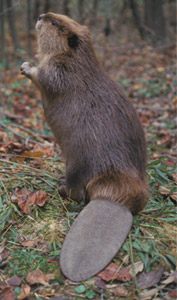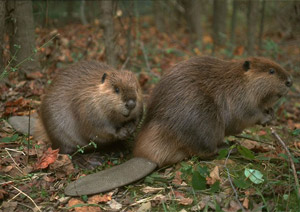Beavers (Castor canadensis) were once rare in Indiana due to overharvesting but are now abundant. In 1935, the Indiana Department of Conservation obtained a few breeding pairs from Wisconsin and released them in Jasper-Pulaski Fish & Wildlife Area. Beaver populations expanded, aided by strategic relocations to certain parts of the state to help with expansion. Presently, beavers are found in almost every county.
Are you a paddler interested in helping conserve and manage wildlife for future generations? Consider volunteering for the Paddlecraft Wildlife Index.
Similar species
 General description
General description
- The beaver is the largest rodent in North America.
- Most adults weigh between 30 and 70 pounds and measure about 4 feet long.
- Like other rodents, the beaver’s front teeth (incisors) grow throughout its life. The backs of their incisors are softer than the fronts so that when they gnaw, the teeth are constantly sharpened.
- The beaver's front feet are adept at digging, grooming, and carrying objects.
- Their large hind feet are webbed for swimming.
- A unique feature is that the second toenail of each hind foot is double or split and is used as a comb to groom their fur.
- The distinctive flat beaver tail is used as a rudder to propel the beaver while swimming. It also supports the body when cutting trees. When startled the beaver smacks its tail on the water, alerting others in the area of possible danger.
- Beavers dive underwater to escape danger and can remain submerged for up to six minutes.
- As ecosystem engineers, beavers are best known for cutting trees, building dams, and adapting their environment to fit their needs.
- Although all beavers can build lodges, most in Indiana build a modified bank burrow with a couple of tunnels that lead from below water level up into the bank to a nest chamber above water level.
Distribution and abundance
During the 1950s, the principal beaver range was the Kankakee River and Tippecanoe River drainage systems. Now, more than 8,000 miles of flowing water and thousands of acres of lakes and ponds in Indiana provide habitat for beavers.
Beavers have few predators except humans. Because they live in small, isolated colonies and are intolerant of newcomers, disease spread is not common and has little effect on population growth.
Reproduction
Beavers can start breeding at 2 years old, though most don’t reproduce until at least 3, especially females. Beavers generally mate in January or February and give birth 107 days later to 3 or 4 kits. Young are weaned between 6 weeks to 2-months old. Juveniles stay with their family groups through their second winter and help raise the next year’s kits. They disperse to find their own territory just before they turn 2. Beavers can disperse between 10 and 60 miles to find new territories.
Food Habits 
Beavers are strict vegetarians.
Winter foods:
- Roots and rhizomes of water lilies.
- Bark and twigs of trees, especially willow and aspen, and other woody plants. Before winter arrives, beaver fell trees, clip branches from the main log, and then stash them in piles underwater. When ice covers the water surface, food is readily available by swimming from the lodge to the brush pile.
Spring and summer foods:
- Leafy parts and roots of aquatic plants, including cattails, duck potatoes, water lilies, spatterdock, grasses, and sedges.
- Willow leaves and twigs.
- Beavers are also very fond of young blackberry canes, and when cornfields are nearby, corn may also be eaten.
Viewing Tips
Beavers like to turn flowing water into pooled water, so they can often be found in places that used to be creeks or streams but are now small pools or wetlands. Often you will see the marks they leave behind before you will see the beaver. Signs of beavers include their distinctive chew marks on trees, their large lodges that are made of sticks and mud, and the dams they build to slow down water, which are also made of sticks and mud but sometimes embellished with other materials. Keep in mind that beavers may switch up where their dams and lodges are built every year. Beavers will slap their tail on the water as a warning to unwanted visitors, so keep your ears open—you may hear a beaver before you see it. They swim with just their head sticking out of the water and their tail completely below water, unlike a muskrat, the tail of which you can see flicking along in the water behind them.
Almost any state property with some water could have a beaver around, but the oxbows, sloughs, and bottomland at Hovey Lake Fish & Wildlife Area support healthy beaver populations. A quiet paddle in some of the nooks and crannies of the lakes and sloughs can be a great way to spot a resident beaver. Kankakee Fish & Wildlife Area is another great property for spotting beavers while on a leisurely drive on the property roads near the Yellow and Kankakee rivers in the early morning or evening. Feel free to stop by the property office to ask a staff member for tips on where a beaver has been spotted lately.
Management and control
Regulated trapping is allowed for beaver during a restricted season. A few thousand beavers are removed annually by licensed trappers during the regulated season, which helps keep beaver populations healthy and addresses conflicts with beavers causing unwanted flooding. The owner or tenant of any property may take beaver discovered damaging property, without a permit, during the closed season. If property owners do not want to trap the beaver themselves, they can contact a licensed wild animal control operator. Relocation of beavers is challenging because beavers are very territorial and will attempt to kill another beaver they find within their territory. With beavers already living in the most suitable beaver habitat, relocation of beavers may not result in positive outcomes for the beavers. Additionally, relocation of beavers causing problems can only occur within the county of capture and onto land with the landowner's permission.
To discourage beavers from chewing down trees, place mesh fencing like woven wire or hardware cloth around tree trunks from the base to at least 4 feet in height. Keep an eye on fencing, as it may need to be adjusted as a tree grows. Alternatively, you can mix sand with a latex or oil-based paint and apply it to the trunk of trees.
A beaver dam is not where a beaver lives. It is simply a mass of woody debris that you might be able to remove without a permit from the DNR, depending on its location and the equipment to be used. Get an outline of permit requirements. Be sure to obtain permission from the property owner(s) if the dam is on property other than your own. Flow pipe or waterflow devices allow water to continue to flow through a dam without it being removed. They can be labor intensive to install and require maintenance but are an alternative to dam removal.
Beaver lodges, which are beaver homes, may only be removed with a nuisance wild animal control permit from the DNR.
